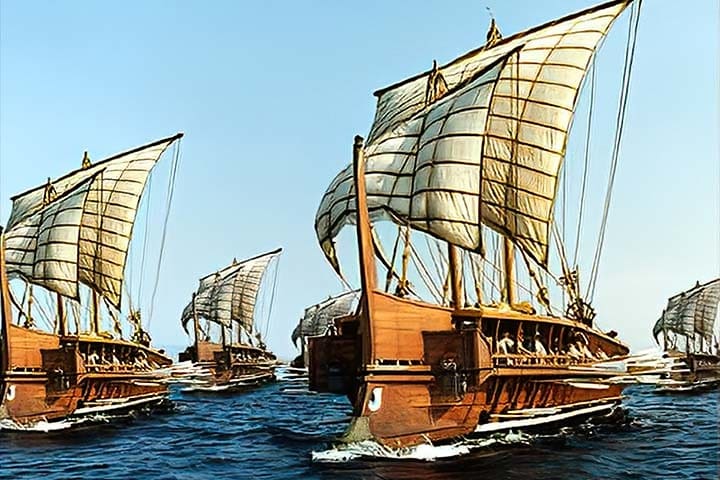

A man of intellect, daring, and logistical genius, Nearchus played a critical role in Alexander’s expansion to the East by executing one of the most ambitious maritime expeditions in the ancient world. Though often overshadowed by the thunderous legacy of Alexander the Great, Nearchus—his admiral and close companion—deserves his place among the great navigators of antiquity.
According to the Roman historian Livy, Nearchus, likely born on Crete but raised in the Macedonian stronghold of Amphipolis, belonged to the inner circle of Alexander’s companions. He was not just a military subordinate but a trusted confidant. While many of Alexander’s generals gained fame through land conquests, Nearchus’ domain was the sea.
Following the conquest of the Indus Valley, Alexander found himself facing a formidable challenge, namely reconnecting his forces by sea from India to the heart of his empire. This wasn’t merely about logistics—it was about proving that his conquests could be sustained and integrated. To do so, he turned to Nearchus.
In 326 BC, Nearchus was assigned command of a fleet to sail from the mouth of the Indus to the Persian Gulf—a largely uncharted, perilous coastline. The significance of this decision cannot be overstated. This wasn’t a retreat or a side mission. It was a strategic pivot to maritime integration. Alexander wanted proof that his empire could stretch across seas, not just overland, and Nearchus, the Navigator, was the man to prove it.

Nearchus’ expedition faced near-impossible odds. The monsoon season had battered the region. The coastline was unfamiliar and often hostile. Supplies were limited, and disease and starvation loomed. Additionally, at one point, Nearchus was forced to wait a full month before setting sail due to weather conditions. Yet he showed exceptional patience, leadership, and strategic flexibility—traits that would be essential to the mission’s survival.
As he moved westward along the Makran coast (modern day Pakistan and Iran), Nearchus’ logbook became a precious record of geography, climate, and local populations. These weren’t just idle observations—they were essential military intelligence. His reports gave Alexander insight into the natural and human terrain of the Indian Ocean basin. This effectively created the first Greek maritime map of the East.
Moreover, Nearchus successfully negotiated with local tribes for supplies, evaded ambushes, and maintained fleet cohesion through a months-long journey that pushed the limits of ancient naval endurance. By the time he reached Hormuz and rejoined Alexander’s land army, he had achieved a feat comparable to the great explorers of the early modern era.

Modern-day Bahrain, known in antiquity as Tylos, stood as a vital maritime waypoint in the grand voyage of Nearchus from the Indus River to the Persian Gulf. It was strategically located along the trading arteries of the ancient Near East. Bahrain served not only as a stopping point for replenishment but also as a conduit of cultural and commercial exchange between Mesopotamia, Persia, and the Indian subcontinent.
When Nearchus and his fleet passed through or near this region, they were navigating waters. These waters had already witnessed centuries of seafaring and trade. His journey didn’t just blaze a new trail. Instead, it linked existing maritime cultures into a broader Hellenistic framework.
In later centuries, Bahrain’s importance as a maritime hub only expanded. It echoed the strategic insights that guided Nearchus’ expedition. Archaeological finds attest to a Greek presence or influence in the area. This is according to Hellenistic stelae and amphorae discovered on the island.
The writer Pierre-Louis Gatier suggests that trade and contact persisted well after Alexander’s campaigns. Nearchus’ expedition helped lay the groundwork for these connections by proving the feasibility of sustained naval movement across the Persian Gulf. His passing through such sites foreshadowed the fusion of Greek, Arab, and Persian maritime traditions that would define the region in the centuries to come.

After reuniting with Alexander, Nearchus faded into the historical background, with sporadic mentions following the king’s death in 323 BC. Unlike Ptolemy or Seleucus, he did not establish a dynasty. He did not carve out a kingdom. His legacy was quieter but in many ways more profound.
Nearchus’ voyage proved that the known world was far larger than previously imagined—and more interconnected. His reports not only influenced Alexander’s short-term plans. They also impacted the future of Hellenistic trade, colonization, and diplomacy. Nearchus established ports, charted routes, and laid a blueprint for a maritime link between Greece and India.
While most of his contemporaries focused their strategic efforts on building empires over land, Nearchus recognized the value of maritime routes. This was a vision that later generations would fully appreciate with the rise of Roman and Arab seaborne trade networks. His was a contribution not of conquest but of connection.
Nearchus, the Navigator, stands as a historical enigma—an admiral without a fleet of fame, a pioneer without the cult of personality. Yet, he was the essential bridge between Alexander’s ambitions and the practical reality of empire. Additionally, with his quiet perseverance and audacious navigation, Nearchus reminds us that not all conquests come by sword. Some come by sail.
